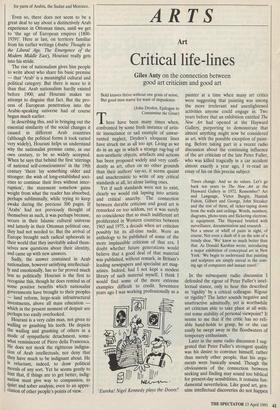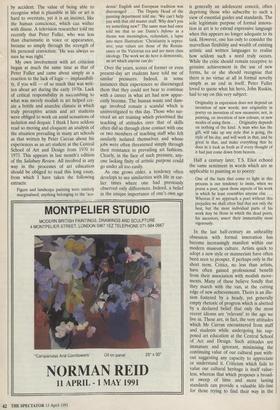ARTS
Art
Critical life-lines
Bold knaves thrive without one grain of sense, But good men starve for want of impudence.
(John Dryden, Epilogue to
TTConstantine the Great) here have been many times when, confronted by some fresh instance of artis- tic insouciance or sad example of unwar- ranted neglect, Dryden's eloquent lines have struck me as all too apt. Living as we do in an age in which a strange rag-bag of non-aesthetic objects, artefacts and actions has been proposed widely and very confi- dently as art, often on no other grounds than their authors' say-so, it seems quaint and anachronistic to write of any critical standards at all, let alone lasting ones.
Yet if such standards were not to exist, clearly we would risk lapsing into artistic and critical anarchy. The connection between durable criticism and good art is remarked on too seldom, yet it was surely no coincidence that so much indifferent art proliferated in Western countries between 1965 and 1975, a decade when art criticism possibly hit its all-time nadir. Were an anthology to be published of some of the more implausible criticism of that era, I doubt whether future generations would believe that a good deal of that material was published, without remark, in Britain's leading newspapers and specialist art mag- azines. Indeed, had I not kept a modest library of such material myself, I think I would find some of the more extreme examples difficult to credit. Seventeen years ago I was working professionally as a 'Eureka! Nigel Kennedy plays the Doors!'
painter at a time when many art critics were suggesting that painting was among the more irrelevant and unenlightened activities anyone could engage in. Twc years before that an exhibition entitled The New Art had opened at the Hayward Gallery, purporting to demonstrate that almost anything might now be considered as art, with the possible exception of paint- ing. Before taking part in a recent radio discussion about the continuing influence of the art criticism of the late Peter Fuller, who was killed tragically in a car accident almost exactly a year ago, I re-read an essay of his on this precise subject: Times change. And so do values. Let's go back ten years to The New Art at the Hayward Gallery in 1972. Remember? Art and Language, Victor Burgin, Hamish Fulton, Gilbert and George, John Stezaker and the rest of them, all ticker-taping down from the walls and ceilings. Words, numbers, diagrams, photo-texts and flickering electron- ic equipment. The Hayward bristled with surveillance, documentation and research .. . Not a smear or whiff of paint in sight, of course. Not even a daub of it on the sole of a trendy shoe. 'We' knew so much better than that. As Donald Karshan wrote, introducing a major exhibition of conceptual art in New York: 'We begin to understand that painting and sculpture are simply unreal in the com- ing age of computers and instant travel.'
In the subsequent radio discussion I defended the rigour of Peter Fuller's intel- lectual stance, only to hear this described as 'rigidity' by a critical colleague. Rigour or rigidity? The latter sounds negative and unattractive admittedly, yet is worthwhile art criticism able to take place at all with- out some stability of personal viewpoint? It seems to me that if the critic has no reli- able hand-holds to grasp, he or she can easily be swept away in the floodwaters of temporary enthusiasm.
Later in the same radio discussion I sug- gested that Peter Fuller's strongest quality was his desire to convince himself, rather than merely other people, that his argu- ments were basically sound. Though the obviousness of the connection between seeking and finding may sound too biblical for present-day sensibilities, it remains fun- damental nevertheless. Like good art, gen- uine intellectual discoveries do not happen by accident. The value of being able to recognise what is plausible in life or art is hard to overstate, yet it is an instinct, like the human conscience, which can wither with disuse. A television researcher told me recently that Peter Fuller, who was less than charismatic in voice or appearance, became so simply through the strength of his personal conviction: 'He was always su sure he was right.'
My own involvement with art criticism began at much the same time as that of Peter Fuller and came about simply as a reaction to the lack of logic — implausibili- ty, if you will — of so much that was writ- ten about art during the early 1970s. Lack of critical responsibility in succumbing to what was merely modish in art helped cre- ate a brittle and anarchic climate in which truly perceptive artists and art students were obliged to work on amid sensations of isolation and despair. I think I have seldom read so moving and eloquent an analysis of the situation prevailing in many art schools as that written by Peter Curran about his experiences as an art student at the Central School of Art and Design from 1970 to 1973. This appears in last month's edition of the Salisbury Review. All involved in any way in the processes of art education should be obliged to read this long essay, from which I have taken the following extracts:
Figure and landscape painting were entirely marginalised; anything belonging to the 'aca- demic' English and European tradition was discouraged . .. The Deputy Head of the painting department told me: 'We can't help you with that old master stuff. Why don't you try something new?' The same man had once told me that to use Dante's Inferno as a theme was meaningless, redundant, a lapse into mere illustration: 'Christianity is repres- sive; your values are those of the Renais- sance or the Victorian era and are mere class ideology. The work we do here is democratic, an art which anyone can do.'
Over the years, scores of former or even present-day art students have told me of similar pressures. Indeed, in some instances their experiences so discouraged them that they could not bear to continue with a career in what art had now appar- ently become. The human waste and dam- age involved remain a scandal which is uninvestigated to this day. Those who sur- vived an art training which prioritised the teaching of attitudes over that of skills often did so through close contact with one or two members of teaching staff who felt similarly isolated themselves and whose jobs were often threatened simply through their resistance to prevailing art fashions. Clearly, in the face of such pressure, any- one lacking fixity of artistic purpose could go under all too easily.
As one grows older, a tendency often develops to see similarities with life in ear- lier times where one had previously observed only differences. Indeed, a belief in the unique importance of one's own age is generally an adolescent conceit, often depriving those who subscribe to such a view of essential guides and standards. The sole legitimate purpose of formal innova- tion in art is to extend expressive language when this appears no longer adequate to its task. However, one has only to consider the marvellous flexibility and wealth of existing artistic and written languages to realise how seldom such a need truly occurs. While the critic should remain receptive to genuine achievement in the use of new forms, he or she should recognise that there is no virtue at all in formal novelty simply as an end in itself. Peter Fuller loved to quote what his hero, John Ruskin, had to say on this very subject:
Originality in expression does not depend on invention of new words; nor originality in poetry on invention of new measures; nor, in painting, on invention of new colours, or new modes of using them . . . Originality depends on nothing of the kind. A man who has the gift, will take up any style that is going, the style of his day, and will work in that, and be great in that, and make everything that he does in it look as fresh as if every thought of it had just come down from heaven... .
Half a century later, T.S. Eliot echoed the same sentiment in words which are as applicable to painting as to poetry:
One of the facts that come to light in this process is our tendency to insist, when we praise a poet, upon those aspects of his work in which he least resembles anyone else ... Whereas if we approach a poet without this prejudice we shall often find that not only the best, but the most individual parts of his work may be those in which the dead poets, his ancestors, assert their immortality most vigorously.
In the last half-century an unhealthy obsession with formal innovation has become increasingly manifest within our modern museum culture. Artists quick to adopt a new style or mannerism have often been seen to prosper, if perhaps only in the short term. Critics, no less than artists, have often gained professional benefit from their association with modish move- ments. Many of these believe fondly that they march with the van, at the cutting edge of new achievements. Theirs is an illu- sion fostered by a heady, yet generally empty rhetoric of progress which is abetted by a declared belief that only the most recent idioms are 'relevant' to the age we live in. These are, in fact, the very attitudes which Mr Curran encountered from staff and students while undergoing his sup- posed art education at the Central School of Art and Design. Such attitudes are immature and ignorant, minimising the continuing value of our cultural past with- out suggesting any capacity to appreciate or understand it. Criticism which fails to value our cultural heritage is itself value- less, whereas that which proposes a broad- er sweep of time and more lasting standards can provide a valuable life-line for those trying to find their way in the
confusing world of contemporary art. To write thus, as the late Peter Fuller sensed, is both a responsibility and a service.




























































 Previous page
Previous page